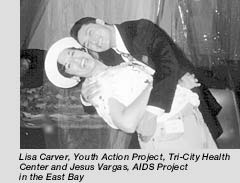|
|
 

Observation is an effective but sometimes labor-intensive way to gather data about
clients, especially about populations that are new to an agency. Observation can be used
to help gather information about individuals to develop new programs. It can also help
gather information about the agency, staff or interventions to provide feedback on
existing programs.
Developing a written procedure for observation BEFORE going out in the
field is crucial. The procedure can consist of a checklist of things to look for, specific
questions to answer, and space for writing in independent notes. This will ensure that the
data is gathered in a systematic and structured way and will make the data more useful.
(See Example: Observation for an example of observation procedures.)
|
 |
|
|
 In Alameda County, Lisa has developed a
contact log for all youth the agency sees. The log tracks the number of times the youth
come to the agency or are seen during outreach. It also notes specific information like
what kinds of condoms or lube they like best, what their living situation is, etc.“ In Alameda County, Lisa has developed a
contact log for all youth the agency sees. The log tracks the number of times the youth
come to the agency or are seen during outreach. It also notes specific information like
what kinds of condoms or lube they like best, what their living situation is, etc.“ Our
outreach staff hates filling out forms more than anything,” said Lisa. “It does
take time. We try to do it right when we get back in the car (after outreach), where the
clients can’t see us with our clipboards. Everyone usually moans and groans when they
start, but then they get excited when they start to recite what happened during outreach.
They realize the impact of their work, and they’re more willing to write it
down.” Our
outreach staff hates filling out forms more than anything,” said Lisa. “It does
take time. We try to do it right when we get back in the car (after outreach), where the
clients can’t see us with our clipboards. Everyone usually moans and groans when they
start, but then they get excited when they start to recite what happened during outreach.
They realize the impact of their work, and they’re more willing to write it
down.”
|
|
Observation can help:
• Determine the best way to attract clients. Observing
a local middle or high school after classes end or during lunch hours can tell you where
teens go after school or at lunch, what time they leave, what kinds of teens hang out at
school, which teens leave immediately, what the ethnic mix of teens is, what kinds of
music they listen to, how many take public transportation, etc.
If teens hang out for an hour after school and before football or basketball games,
that might offer a window where teens have nothing to do and might look for an activity to
fill the time. It could be a good time to open a drop-in center or offer a short
social/educational activity.
• Determine needs and habits of
clients. Observing a shooting gallery or other public drug use area can
tell you if users share needles, if they clean between use and how they clean, if they
sell needles, if they trade drugs for sex, what kinds of drugs they use, and if there are
other drugs being used.If drug users are sharing needles and cleaning practices are
inadequate, outreach workers might want to do needle cleaning demonstrations, hand out
bleach, or hand out cards with times and locations of needle exchange services.
• Determine availability of safer
sex supplies. To find out if condoms are both available and easily
accessed, staff can visit a few drug stores in the community to see what brands of condoms
are being sold, whether they are in an aisle or behind a counter, and if customers need to
ask a clerk for them. Staff can also visit local bars or hangouts to see if there are
condom machines in the bathrooms.If customers need to ask a clerk for condoms, a
discussion with the store manager or pharmacist might alert them to the need for easy
access without embarrassment.
• Determine acceptability of
programs. Observing a peer educator conducting an intervention, or a
needle exchange site, or a safer sex rave or volleyball game can tell you more about a
program that’s in progress. Do clients seem bored, talk eagerly with the staff, leave
before the end of the activity? Do participants worry that someone might see them coming,
or take off if police or adults are nearby?
If clients seem to lose interest at the end of an educational session, perhaps it needs
to be shortened by 15 to 30 minutes. If clients disappear when police cruise by, perhaps a
meeting with the local beat police or chief is needed to try to explain what the agency is
trying to accomplish.
NOTE: Observers should be chosen and trained not to attract undue
attention to themselves so that they don’t influence how people behave. For example,
if an outreach worker is already well known in the community, her presence might be a
reminder not to drink or share needles. If an observation is being done on an existing
program, it is best conducted by someone other than intervention staff so that the
observation remains neutral.
 
|
|